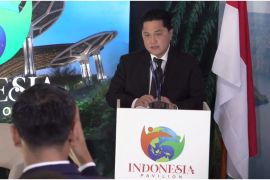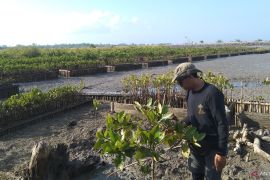Mangrove forest conservation should be part of the discussions on the important role of tropical wetlands and climate changeJakarta (ANTARA News) - Mangrove forests - a common natural feature of tropical and subtropical coastlines - are among the most biologically important ecosystems on earth.
But in Indonesia, ground-based evidence suggests these vital coastal forests have been decimated or damaged in many regions across the country.
Launching a mangrove planting campaign along the coast of Ambon Bay in Maluku some time ago, Forestry and Marine Affairs Minister Fadel Muhammad admitted that around 70 percent of mangrove forests in Indonesia were in critical condition and seriously damaged.
The minister cited lack of public awareness as a factor which has caused the degradation of mangrove forests in many Indonesian regions.
Realizing that mangroves can function as fortresses against tidal wave disasters and coastal abrasion, Angeline Sondakh, a member of the House of Representatives (DPR)`s Commission X said here on Monday that they need proper management.
After getting information about the examination results of the Supreme Audit Board (BPK) concerning mangrove forest management performance in the Malacca Strait area, Angelina, also an environmental activist, said mangrove forests management in the country should be stepped up.
"BPK has disclosed that there are some weaknesses in the policies and systems of internal control and non-compliance with the existing rules on sustainable management of mangrove forests," Angelina said.
She also said that mangrove forest rehabilitation, utilization, conservation, and protection efforts had not been as effective as expected.
"The function of mangrove forests as coastal eco-system buffers has to be improved and maintained," Angelina said.
Meanwhile, a researcher said Indonesia should prioritize mangrove forest conservation as a way to overcome climate change.
"Mangrove forest conservation should be part of the discussions on the important role of tropical wetlands and climate change," senior researcher of the Center for International Forestry Research (CIFOR) Daniel Murdiyarso said at a seminar on wetlands in
Denpasar, Bali, on Monday.
Daniel said the result of a scientific research by CIFOR and the US Forest Service showed that mangroves store exceptionally more carbon than most tropical forests, but they were being destroyed at a rapid rate causing significant emissions of greenhouse gases.
The outcome of the research was contained in a paper titled "Carbon-rich tropical mangroves and climate change mitigation in a time of rising seas" published by the Nature GeoScience.
Daniel said that according to a new study in Nature GeoScience, mangroves might be the world`s most carbon rich forests to store up to four times as much carbon as other tropical forests including rain forests.
Therefore he called on the Indonesian government to pay as much attention to mangrove forests as to peat forests and develop even better policies to protect mangrove forests.
Daniel suggested that the government make a policy, applying an international initiative know as REDD+ (reduced emissions from deforestation and forest degradation) which was considered one of the most cost-effective ways to slow the rate of climate change.
The findings from the study, which was carried out by scientists from the Center for International Forestry Research (CIFOR) and the USDA Forest Service, underscore a call by scientists for mangroves to be protected as part of global efforts to combat climate change.
"Mangroves are being destroyed at an alarming rate. This needs to stop. Our research shows that mangroves play a key role in climate change mitigation strategies," Daniel Murdiyarso said.
In the study, which was published on April 3 in Nature Geoscience, scientists quantified carbon storage in mangroves across a large tract of the Indo-pacific region.
"No studies to date have integrated the necessary measurements for total mangrove carbon storage across broad geographic domains," he said.
From the results, the scientists estimated that the destruction and degradation of mangrove forests may be generating as much as 10 percent of all the global deforestation emissions despite accounting for just 0.7 percent of tropical forest area.
Much of that carbon is stored in the ground below the mangroves forests that can be seen above the ground and water.
Deforestation and land-use change currently account for 8 percent to 20 percent of all global carbon emissions, second only to the use of fossil fuels.
Mangroves occur along the coasts of most major oceans in some 118 countries.
A 30 percent to 50 percent decline in mangroves over the past half-century has raised fears that they may disappear altogether in as little as 100 years.
Rapid 21st century sea level rise has also been cited as a primary threat to mangroves, which have responded to past more gradual sea-level changes by migrating landward or upward.
Under current climate trends, sea level is projected to rise 18-79 centimeters this century - and even higher if ice-sheet melting continues accelerating.
Mangroves are also being threatened by increasing pressures from urban and industrial developments, as well as fish farms.
"There is a lack of awareness of the full implications of mangrove loss for humankind," Murdiyarso said, adding that there was an urgent need for the government to acknowledge mangroves` importance and develop better policies to ensure their protection.
He said mangroves are not only key to climate change mitigation efforts, they also play important roles in adapting to the changing climate.
Mangroves, according to him, protect coastlines from storm surges and fluctuations in sea levels, including from devastating tsunamis.
He said mangroves have long been known as extremely productive ecosystems that cycle carbon quickly, but until now there had been no estimate of how much carbon resides in these systems.(*)
Reporter: Otniel Tamindael
Editor: Aditia Maruli Radja
Copyright © ANTARA 2011










